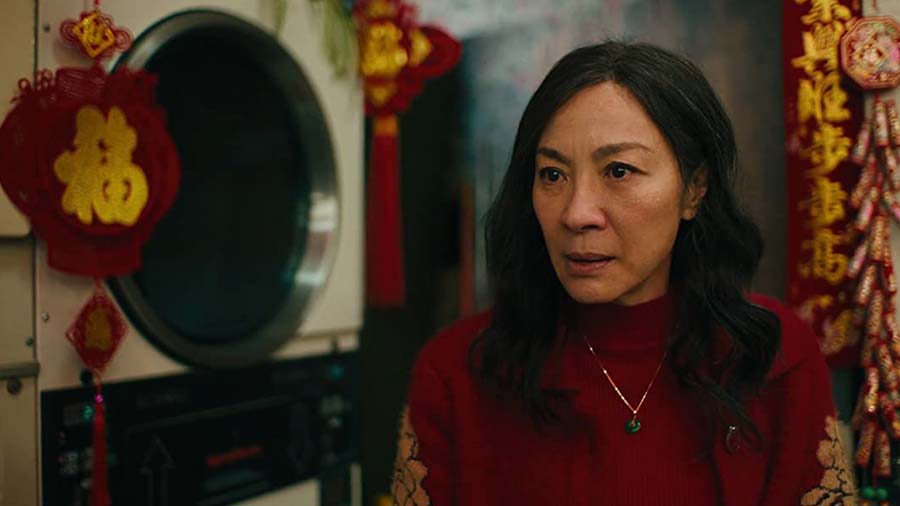The Academy Awards have come a long way since being criticised for being ‘too white’. Back then, the acting nominees would be largely white and the nominated directors would hardly have any women or people of colour. But the tides are turning. And across categories and nominations, an indie film made by a duo of absurdist filmmakers with a majority Asian cast is shining through this awards season.
Everything Everywhere All At Once, which picked up trophies at the Globe Globe, Critics’ Choice and Screen Actors Guild awards over the past two months, is clearly the most significant film at the 95th Academy Awards despite not having any traditional tools in their favour, at least not on the surface.
The filmmakers — Daniel Kwan and Daniel Scheinert — are relatively unknown, having only made the Sundance darling, Swiss Army Man, together before this, starring Paul Dano and Daniel Radcliff. The lead actress, Michelle Yeoh, is typecast as a martial artist heroine in films across decades. The supporting actor, opposite Yeoh, and arguably the soul of the film, is Ke Huy Quan, a once successful child actor who failed to bag acting roles in the last two decades. The tool of multiverse is now overused exhaustively over comic book movies in the last decade. The film’s genre isn’t clear: is it sci-fi? Is it fantasy?
So there really wasn’t anything which were, theoretically, crowd-pullers. And that’s where the most important ingredient of Everything Everywhere All At Once comes into play: the script.
The ambition and the possibilities with the script were endless. And since it wasn’t made on pre-existing IPs and franchises, audiences didn’t know what to expect, in a good way. Absurdist filmmaking allows you to blend genres — relying on comedy, crowd-pleasing sequences and a core dramatic conflict to really engross you in an experience you weren’t ready for. Absurdist films can range anywhere from Eraserhead to The Lobster. You could aim for anywhere in between, or go beyond.
A mother-daughter story about undoing generational trauma
Though wrapped in multiverse travel, the film, at its core, is about none of them. Everything Everywhere All At Once is ultimately a mother-daughter story about undoing generational expectations and trauma and making room for change and reform. It’s a beautiful message that resonates with people across age brackets, cultures and classes. Of course having pop culture references sprinkled throughout the film added an extra layer of relatability to it, but beyond that they’re just conversation-starters.
Indie production house A24 came onboard to finance and distribute the film with Anthony and Joe Russo, the directors of Infinity War and Endgame, attached as executive producers. The support system was solid. The film has been extensively written about. We all know how beautifully the story has been told and how neatly it has been executed. But as is the case with many well-made films under the radar, just having a good story and a well-made film only takes you so far. Branding is important. And here, Everything Everywhere All At Once excelled.
The film was made with a production budget of 17 million USD, which in the context of indie films is a lot of money, but when you take into account the multiverse-spanning action nature of it, it suddenly seems less. The restraint on the budget allowed the filmmakers and the cast members to find real tangible solutions to create the absurdity, rather than rely heavily on green screens and a big team of VFX artists. Lower budgets inherently give films a sense of rawness which is lost under layers of rendering in higher-budget films.
Because the spirit is unadulterated, the absurdity is unapologetic
Everything Everywhere All At Once relied heavily on martial arts sequences. In the hands of any other filmmaker, an experienced action coordinator would’ve been roped in to choreograph it but here the MartialClub, a team of martial artists that became popular on YouTube with their unique homemade fighting style videos, were selected for the job. It’s an interesting decision given that the two Daniels and MartialClub share similar creative beginnings. In both cases, a team of friends experimented with the video format — VFX and AfterEffects for Kwan and Scheinert; martial arts recreations and action comedy for MartialClub — and used those years of hobbyists’ experience to create something truly unique and fresh, with the same spirit they’d make their home videos for followers on YouTube.
Because the spirit was unadulterated, the absurdity was unapologetic. I mean, who’d imagine having Michelle Yeoh fight in the climax scene with a googly eye stuck as a symbol for her ‘third eye’? Out of context, this sounds ridiculous. But Kwan and Scheinert were able to achieve the impossible. It’s with these unique elements that were both crazy and integral plot points in the visual narrative — such as the googly eye, the auditor of the year award/butt plugs, or having a scene where two rocks converse — that they were able to create conversations outside of the movie-watching experience itself. Through memes. Through GIFs. Through T-shirt arts. By referencing pop culture and indulging in their creative instincts, they became just that — a part of the same pop culture.
Possible to have serious conversations without being serious
Some films make you laugh, some make you cry, some just want you to introspect and talk about them. Everything Everywhere All At Once does all of that without taking itself too seriously. Often films, especially films about and by Asians (with an emphasis on Indian cinema) and films that deal with thematically serious subjects, tend to lean majorly towards serious tonality and execution. Kwan and Scheinert show us that it’s possible to have serious conversations with the audience without the baggage of a serious dramatic film.
The poster of the film is a nod to Chinese martial art films of the 1980s and ’90s, some of which Yeoh has starred in. Everything Everywhere All At Once world-premiered at the South By Southwest Film Festival in Austin, Texas, a worthy launchpad for the kind of film it promises to be. Having gained an initial positive review, the film released in March 2022, a period not necessarily aimed by producers and distributors for marketing Oscar contenders: a bad strategic move. Perhaps A24 didn’t think much of Everything Everywhere All At Once succeeding before its release, nor did the filmmakers have any track record of delivering box-office hits. But the release proved to be a different story. In a post-pandemic world when big-budget blockbusters were reduced to only Marvel and DC spectacles, Everything Everywhere All At Once promised a newer world with a similar grandness.
Out of the shadow of Multiverse of Madness
The film was released around the same time as another multiverse film — and a franchise film nevertheless — Dr Strange in the Multiverse of Madness. Of course, it’s redundant to compare the budget and financial recovery of the two films. One is an indie film made with lesser-known but bankable stars, the other has Benedict Cumberbatch in the lead.
The economics of theatrical distributions also come to play. Disney will make no errors in marketing the film well, especially when they are aware of a similar themed film coming out of the critically loved A24 label. Moreover, Multiverse of Madness had a higher demand because of the promise of cameos which the film delivered on. On the other hand, Everything Everywhere All At Once’s popularity climbed slowly but steadily, which is understandable given it’s an R-rated film that wasn’t as heavily distributed worldwide on the same day as Multiverse of Madness.
While box office numbers tell a different story, audiences and reviews have favoured Everything Everywhere All At Once. It had the world of the Marvel film but came with a heartfelt story, which was completely lacking in the Sam Raimi-directed blockbuster. And perhaps by releasing it around the same time, coupled with A24’s theatre-first marketing strategy, Kwan and Scheinert managed to gather more attention to their film than they would have been able to otherwise. Sometimes, the bigger opponent brings attention to the underdog.
It’s about how despite an early release in the year, Everything Everywhere All At Once has remained in conversations, social media memes and serious film reportage, ultimately prompting the Academy of Motion Picture Arts and Sciences to take the film seriously. Seriously enough for some Oscar nominations. Eleven nominations, the most in the year.











